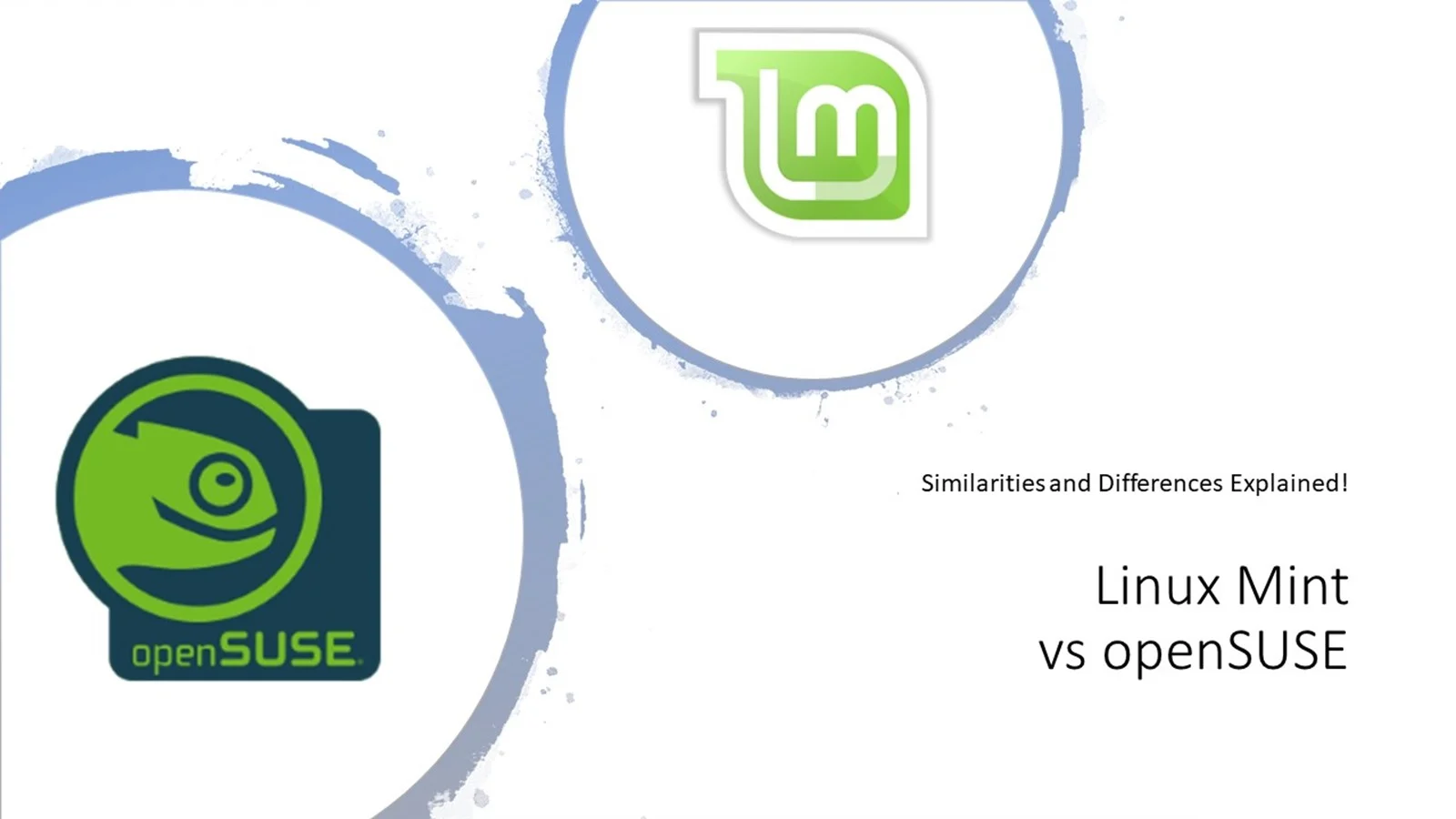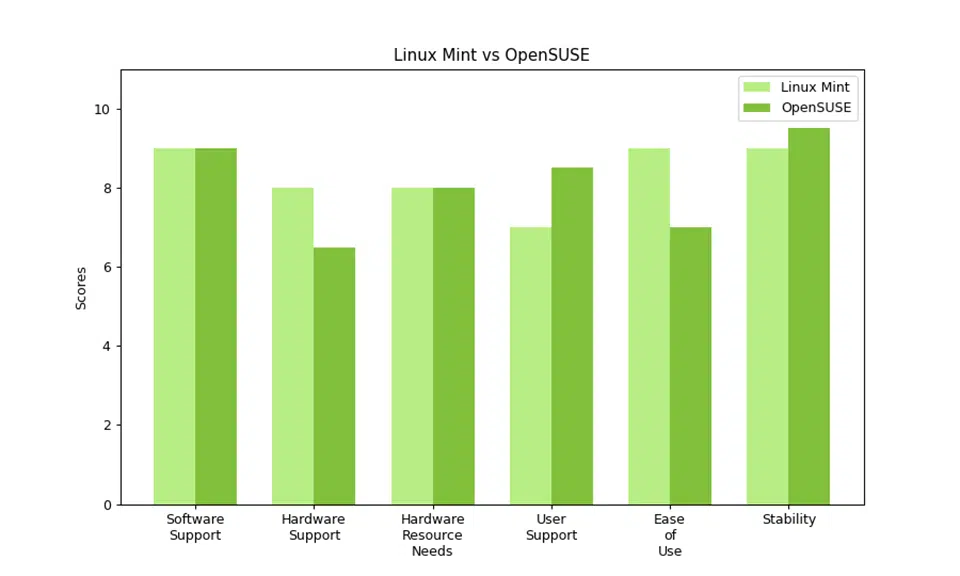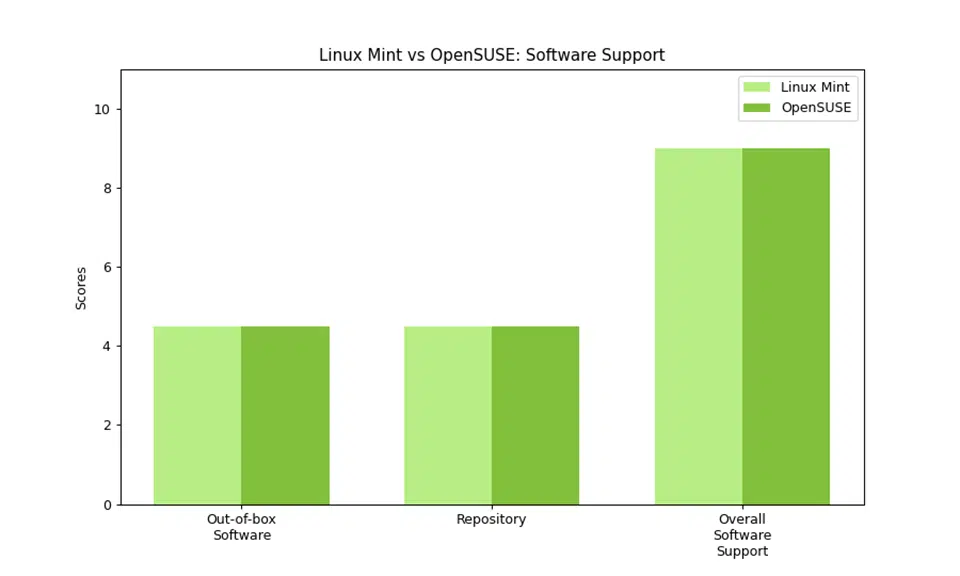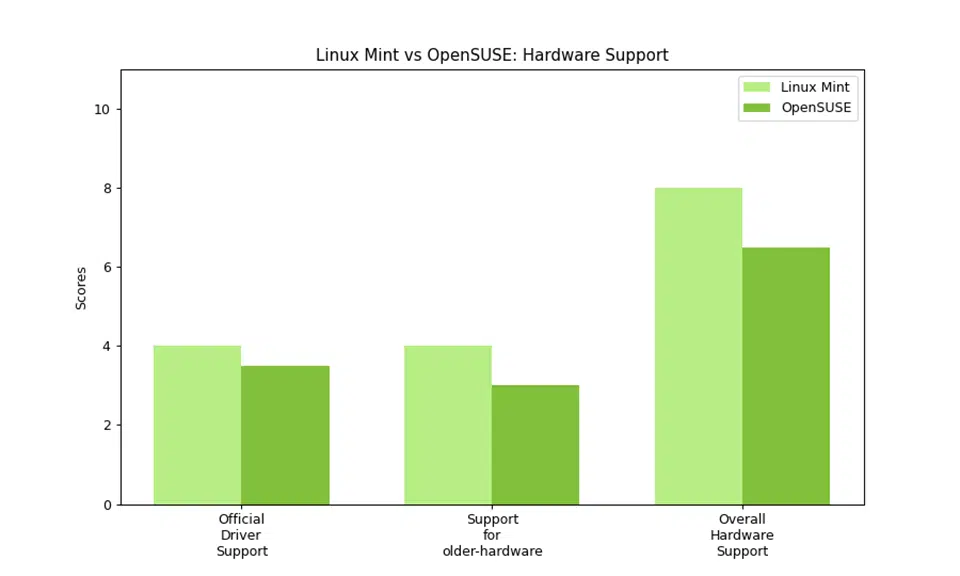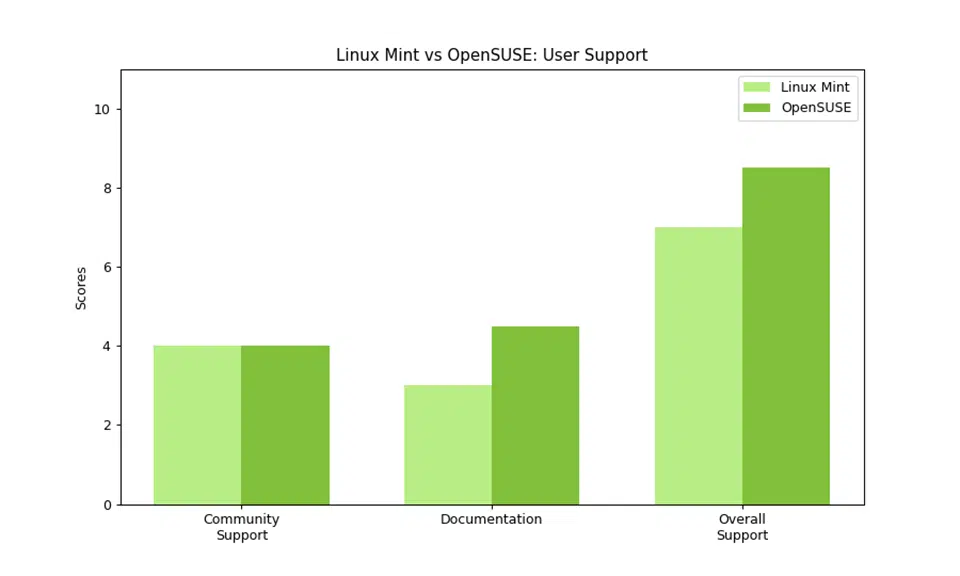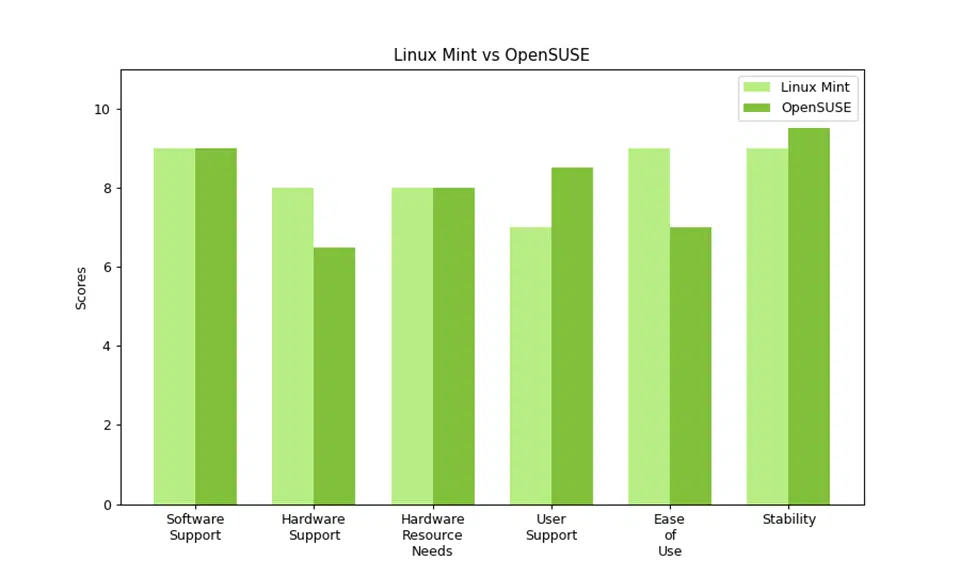Credits:
In this article let us have a look at 2 very popular distros Linux Mint and OpenSUSE and see where each distro shines so that you can pick one that best suit your needs!
For those of you in a hurry, here is the short version of the answer.
The Short Version Of The Answer
What are the differences between Linux Mint and OpenSUSE? The main difference between Linux Mint and OpenSUSE is Linux Mint is meant for beginners who are looking for the best workstation distro while OpenSUSE is meant for intermediate/advanced users who need a stable workstation distro
The table below highlights the important differences between the 2 distros
| Linux Mint | OpenSUSE | |
| Organization Name | This is a community-driven distro based on Ubuntu and Debian focused on providing an easy to use and stable operating system.
Organization Type: Community |
OpenSUSE is the community version of SUSE enterprise Linux.
Organization Type: Community Backed by SUSE |
| Expertise Level Needed | Beginner | Intermediate/Advanced |
| Based On | Ubuntu and Debian | SUSE Enterprise Linux |
| Target Use-cases | General-purpose Distro.
Best Use-case: For use in a workstation Other use cases: any use case that needs stability and ease of use, but not the latest software packages. |
specific purpose Distro
Best Use-case: Servers Other Use-cases: Sysadmins, Linux Developers |
| Software Support | 9/10 Out of the box software: 4.5/5 Software Repository: 4.5/5 Since Mint has versions based on Ubuntu LTS and Debian Stable, there is very good software support of about 30,000 packages |
9/10 Out of the box software: 4.5/5 Software Repository: 4.5/5 |
| Hardware Support | 8/10 Official driver support: 4/5 Support for older hardware: 4/5 |
6.5/10 Official driver support: 3.5/5 Support for older hardware: 3/5 |
| Hardware Resource Needs | Middleweight | Middleweight |
| Support | 7/10 Paid support: Not available Community: 4/5 Very good online community support Documentation: 3/5 Enough documentation for beginner level use |
8.5/10 Paid support: Can hire experts(if you opt for the enterprise version of SUSE you can get 24×7 support for an yearly subscription) Community: 4/5 Documentation: 4.5/5 |
| Ease of use | 9/10: Easy
All multimedia codecs and Proprietary drivers work out of the box |
7/10 Intermediate/Advanced |
| Stability | 9/10: Very stable
Stability is one of the main focuses of this distro |
9.5/10: Very stable |
| Release Cycles | Fixed Release: Usually a month behind Ubuntu’s LTS releases | Leap: Fixed Release
12 months: minor release 36 to 48 months: major release Tumbleweed: Rolling release |
The graph below summarizes the table and compares the 2 distros and shows us how they compare with each other on various factors (Higher the points the better that particular feature is in a given distro)
That is just the short version of the answer, let’s go ahead and look at the longer and more informative version and learn more about the similarities and differences between 2 distros.
The Linux Distributions World
The word Distro is short for “Distribution”. Since the Linux source code is open for everyone to see, large communities started evolving to bring together Operating Systems suited towards specific needs/goals.
These “specific needs/goals” include, but not limited to the following.
- producing documents
- writing programs and creating software
- editing pictures, videos, audio and multimedia-production related works
- store sensitive information by securing the operating system so that no one can hack into it or
- just browse the internet and consume media.
Say a community of people just wanted to browse the internet with their computers, then there is no point giving them the software to write programs in. Thus since every community’s needs and goals were different these communities started distributing built images of this operating system with all the essential tools installed. These prebuilt images are called distros!
If you wish to know more about the reason behind the presence of so many choices in the Linux World, I suggest reading the article given below.
Reasons Behind The Existence of SO MANY Linux Distros: An Analysis!
The Main Factors of Comparison
The factors mentioned above are just a small list of 100s of factors that differentiate distros. If you are either switching from some other OS to Linux or you are in the process of choosing your next Linux distro and you are confused which one to choose, you need to have a look at these top 5 decision-making factors
- Factor#1: Good Match with your Particular use-case
- Factor#2: Support for your favorite software
- Factor#3: Hardware Support and Proprietary Driver Support
- Factor#4: Your level of expertise in Linux
- Factor#5: Hardware Resource Needs
I have written a separate article explaining these factors which you can find in the link below
Top 5 Factors To Choose Between Linux Distros!
Let’s have a look at each of these important factors and see how Linux Mint and OpenSUSE compare against each other.
Factor#1: Good Match with your Particular use-case
By use-case, I mean the type of work you are going to be doing on your computer. The Linux distro world originated because of the difference in use cases.
Linux Mint’s goal is wildly different from that of OpenSUSE’s.
Let’s have a brief comparison between Linux Mint and OpenSUSE in terms of goals, target users, and best use cases to employ these distros.
| Linux Mint | OpenSUSE | |
| Goal | To be a beginner-friendly distro with most things working out of the box with a focus on stability and user experience | To be the testing ground for the software before releasing to the SUSE’s commercial distro |
| Target users | Beginners looking for a stable distro with good GUI tools and are not into learning to use the command line. | System admins who wish to get a flavor of SUSE’s advanced tools like SUSE studio, and openQA |
| Best Use-Cases to Employ the Distro | Best Use-case: For use in a workstation Other Use-cases: any use case that needs stability and ease of use, but not the latest software packages. |
Best Use-case: Servers
Other Use-cases: Sysadmins, Linux Developers |
Factor#2: Support for your favorite software
If your main work involves some specific software or the latest versions of a given software then that becomes a decision-making factor for choosing a Linux Distribution. So before fixing on a given distro, be sure to google if that distro has official support for your main software needs.
The factors you need to be considering include the following
- Out of the Box support: The software that the distro ships with
- Repository Support: The curated software that is available on the official repos
- Type of release cycle: This decides the trade-off between up-to-date software and stable tested software.
- Availability of Graphical Software managers
- Package manager used: This can decide the ease of which you can install and uninstall software
Let’s see how Linux Mint and OpenSUSE fair up against each other in the category of Software support
| Linux Mint | OpenSUSE | |
| Out of the Box Software | 4.5/5: Proprietary drivers and multimedia codecs work out of the box, also all basic tools are included | 4.5/5 During installation, you get to choose which software you need and hence you get more control over what you get out of the box! |
| Repository Support | 4.5/5: The official repo supports around 30,000 packages (at the time of this writing) | 4.5/5 OpenSUSE uses rpm packages which means you get access to all the RHEL’s packages! |
| Type of release cycle | Fixed Release: Usually a month behind Ubuntu’s LTS releases | Leap: Fixed Release
12 months: minor release 36 to 48 months: major release Tumbleweed: Rolling release |
| GUI Software Management Tools | Available
Ubuntu’s Synaptic manager and Mint’s Software manager are available for the end-user |
Available
YaST (Yet another Setup Tool) |
| Package manager used | APT, snappy | Zipper and rpm |
The bar chart below summarizes the table above. As you can see, both OpenSUSE and Linux Mint got the same points in terms of Out of the box software support. Both OpenSUSE and Linux Mint got the same points in terms of Repository support.
Hence, this round is a tie between OpenSUSE and Linux Mint!!
Refer to the article below if you wish to learn more about package managers.
A Beginners Introduction To Linux Package managers: apt, yum, dpkg & rpm
Factor#3: Hardware Support and Proprietary Driver Support
Not all Linux distros support proprietary drivers officially. Depending on your computer’s hardware, you may or may not have open-source driver support from the manufacturers. This is especially true for hardware such as graphics cards and network cards. Hence it is a good idea to take “driver support” into consideration while choosing your next distro.
The factors you need to be considering include the following
- Distro’s Policy of use of opensource vs proprietary 3rd party software
- Official driver support by Major Companies
- 3rd party driver support from official repos
- Support for older hardware
Linux Mint OpenSUSE Distro’s Policy Proprietary drivers officially supported and are available out of the box Only opensource officially supported Official driver support by Major Companies 4/5: There is no official support directly for Mint, but Ubuntu gets a lot of love from software, and hardware producers and Mint users benefit from those! 3.5/5: This distro is not as famous as others hence official driver support directed towards OpenSUSE is limited! 3rd party driver support 3rd party repos available for installing software that is not up-to-date/available in the official repos 3rd party repos available Support for older hardware 4/5: has both 32 and 64-bit versions and has a good collection of drivers to support old hardware. 3/5: OpenSUSE dropped support for 32-bit processors, but driver support for older hardware other than processor is good
The bar chart below summarizes the table above. As you can see, Linux Mint is better than OpenSUSE when it comes to official driver support. Linux Mint is better than OpenSUSE in terms of support for Older Hardware.
Hence, Linux Mint wins the round of Hardware support!
Refer to the article below if you wish to have a look at some of the top distros in terms of hardware support.
Best Distro For Software And Hardware Support: A Comparison!!
Factor#4: Your level of expertise in Linux
Depending on your level of expertise in Linux, the choice of the distro you need will vary. This is because of the following factors
- Ease of use: beginner, intermediate, expert
- Paid customer support: available, not available
- Online community support: great, good, okay, not good, no support
- Available Documentation: Great documentation, Good documentation, Okay documentation, no documentation
Let’s see the level of support available for Linux Mint and OpenSUSE and see how they compare against each other
| Linux Mint | OpenSUSE | |
| Ease of Use | Beginner level: Extremely Easy to Use | Intermediate/advanced |
| Paid Customer Support | Not available, hence might not be the best choice for organizations | Not available, but customers can opt for the SUSE Linux Enterprise Desktop to get paid support if needed |
| Online Community Support | 4/5: very good online community support and forums. Also, solutions for similar problems on Ubuntu usually work with Linux Mint. | 4/5: good online community support |
| Documentation | 3/5: Enough documentation for beginner level use |
4.5/5: Good documentation available as this is based on an enterprise product |
The bar chart below summarizes the table above. As you can see, both OpenSUSE and Linux Mint got the same points in terms of online community support. OpenSUSE is better than Linux Mint in terms of Documentation.
Hence, OpenSUSE wins the round of User support!
Factor#5: Hardware Resource Needs
This is an important factor if you are planning to employ Linux on a computer with limited hardware resources. This may be an old machine or a new one with less than stellar specs.
The factors you need to be considering include the following
- Category: Lightweight or Middleweight or Heavyweight
- RAM Requirements to have a snappy system &
- Minimum processor requirements
Let’s see how Linux Mint and OpenSUSE fair up against each other in terms of Hardware resource needs
| Linux Mint | OpenSUSE | |
| Category | Middleweight | Middleweight |
| Minimum RAM requirements | 1GB (2GB recommended) | 1 GB physical RAM
2 GB recommended |
| Minimum Processor Requirements | X86 32bit processor | Pentium* 4 1.6 GHz or higher processor |
Refer to the article below if you wish to have a look at a step by step guide for choosing a Linux distro for your computer’s specifications.
A Complete Guide For Choosing A Distro For Your Computer’s Specs..!!
The Results!
Let us know go ahead and see the results of our comparison! Have a look at the Bar chart below.
As you can see Linux Mint wins in Hardware Support, and Ease of use.
OpenSUSE wins in User support and Stability.
There is a tie between the 2 distros in Software support, and Hardware Resource needs.
I suggest you pick the distro that best suits you based on this graph. For example, if hardware support is more important to you, then pick the distro that has better support for your hardware!
Summary
To summarise the article here is the comparison table from the beginning of the blog again.
| Linux Mint | OpenSUSE | |
| Organization Name | This is a community-driven distro based on Ubuntu and Debian focused on providing an easy to use and stable operating system.
Organization Type: Community |
OpenSUSE is the community version of SUSE enterprise Linux.
Organization Type: Community Backed by SUSE |
| Expertise Level Needed | Beginner | Intermediate/Advanced |
| Based On | Ubuntu and Debian | SUSE Enterprise Linux |
| Target Use-cases | General-purpose Distro.
Best Use-case: For use in a workstation Other use cases: any use case that needs stability and ease of use, but not the latest software packages. |
specific purpose Distro
Best Use-case: Servers Other Use-cases: Sysadmins, Linux Developers |
| Software Support | 9/10 Out of the box software: 4.5/5 Software Repository: 4.5/5 Since Mint has versions based on Ubuntu LTS and Debian Stable, there is very good software support of about 30,000 packages |
9/10 Out of the box software: 4.5/5 Software Repository: 4.5/5 |
| Hardware Support | 8/10 Official driver support: 4/5 Support for older hardware: 4/5 |
6.5/10 Official driver support: 3.5/5 Support for older hardware: 3/5 |
| Hardware Resource Needs | Middleweight | Middleweight |
| Support | 7/10 Paid support: Not available Community: 4/5 Very good online community support Documentation: 3/5 Enough documentation for beginner level use |
8.5/10 Paid support: Can hire experts(if you opt for the enterprise version of SUSE you can get 24×7 support for an yearly subscription) Community: 4/5 Documentation: 4.5/5 |
| Ease of use | 9/10: Easy
All multimedia codecs and Proprietary drivers work out of the box |
7/10 Intermediate/Advanced |
| Stability | 9/10: Very stable
Stability is one of the main focuses of this distro |
9.5/10: Very stable |
| Release Cycles | Fixed Release: Usually a month behind Ubuntu’s LTS releases | Leap: Fixed Release
12 months: minor release 36 to 48 months: major release Tumbleweed: Rolling release |
Hope you have got enough data to choose between these 2 amazing distros!
And with that, I will conclude this article!
I hope you guys enjoyed this article and learned something useful.
If you liked the post, feel free to share this post with your friends and colleagues!
Related Articles
Here are some of my other articles that might interest you!
What Is The Best Linux Distro? Analysis & Comparison..!!
A Step By Step Plan To Learn Linux..!
Best Linux Distro For Workstation: Analysis and Comparison!!
A Complete Guide For Choosing A Distro For Your Computer’s Specs..!!
Best Distro For Software And Hardware Support: An Analysis.!!
Distro-Hopping, What, Why & How Explained!
Reasons Behind The Existence of SO MANY Linux Distros: An Analysis!

